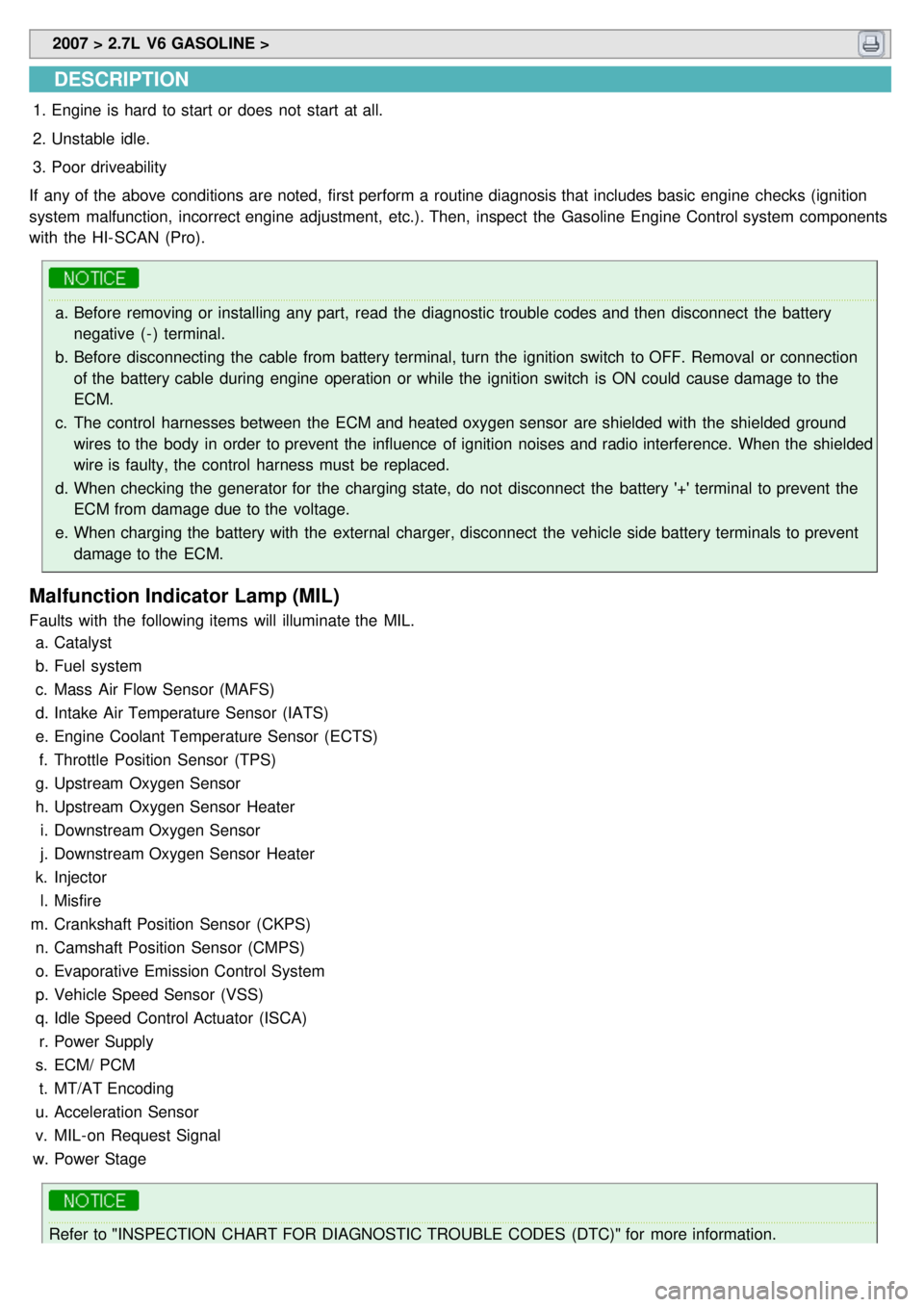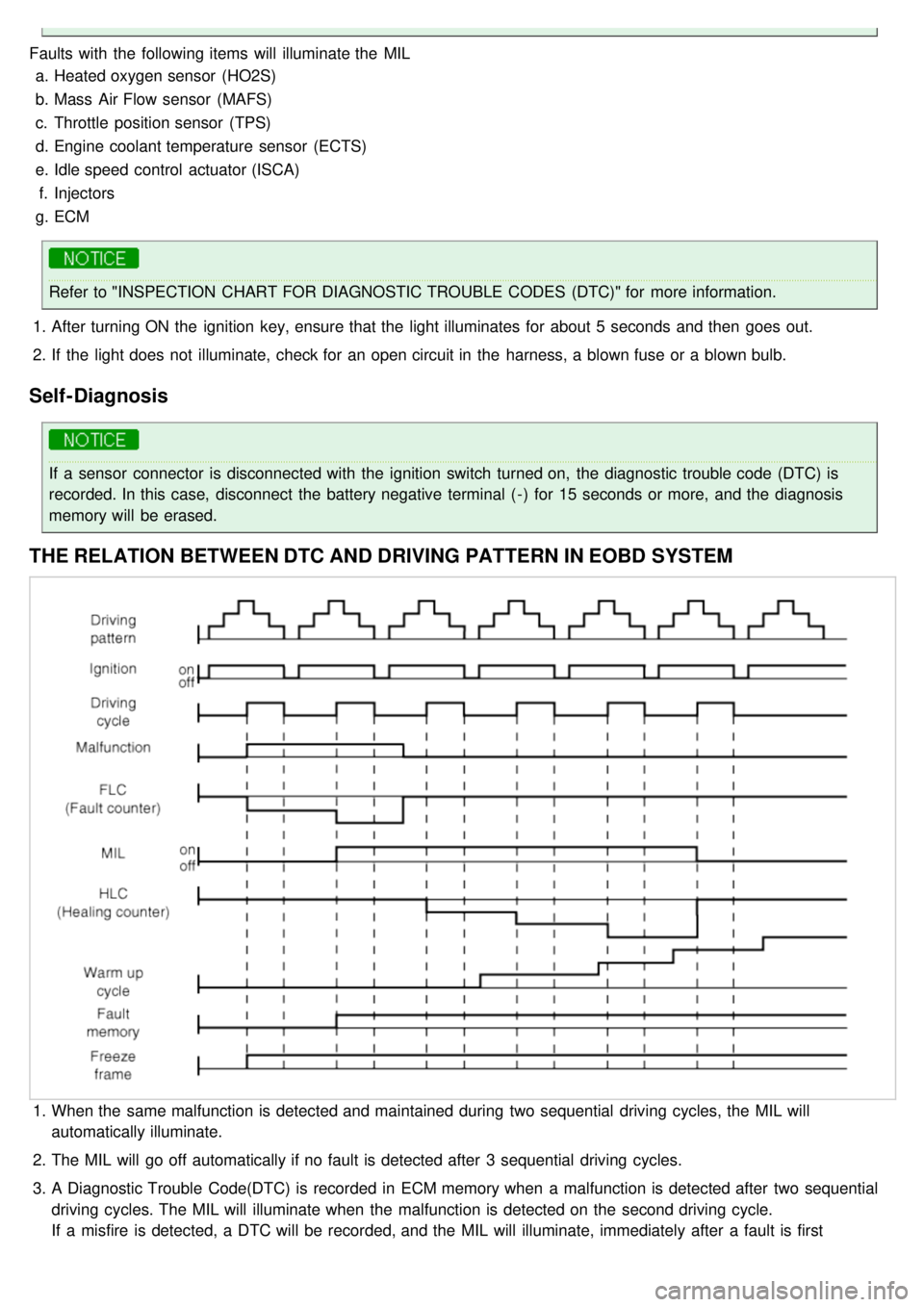Page 236 of 1575
![KIA CARNIVAL 2007 Workshop Manual Coil Resistance (Ω)6.7 ~ 7.7 [20°C (68°F)]
CVVT OIL CONTROL VALVE (OCV) [BANK 2]
�J Specification Item Specification
Coil Resistance (Ω) 6.7 ~ 7.7 [20°C (68°F)]
ETC MOTOR
�J Specificati KIA CARNIVAL 2007 Workshop Manual Coil Resistance (Ω)6.7 ~ 7.7 [20°C (68°F)]
CVVT OIL CONTROL VALVE (OCV) [BANK 2]
�J Specification Item Specification
Coil Resistance (Ω) 6.7 ~ 7.7 [20°C (68°F)]
ETC MOTOR
�J Specificati](/manual-img/2/57045/w960_57045-235.png)
Coil Resistance (Ω)6.7 ~ 7.7 [20°C (68°F)]
CVVT OIL CONTROL VALVE (OCV) [BANK 2]
�J Specification Item Specification
Coil Resistance (Ω) 6.7 ~ 7.7 [20°C (68°F)]
ETC MOTOR
�J Specification Item Specification
Coil Resistance (Ω) 1.275 ~ 1.725 [20°C (68°F)]
IGNITION COIL
�J Type: Stick type
�J Specification Item Specification
1st Coil Resistance (Ω) 0.62Ω±10�Ë [20°C (68°F)]
2nd Coil Resistance (kΩ) 7.0kΩ±15�Ë [20°C (68°F)]
SERVICE STANDARD
Ignition Timing BTDC 7°± 10°
Idle Speed A/CON OFF
Neutral,N,P - range
650 ± 100 rpm
D- range 650 ± 100 rpm
A/CON ON Neutral,N,P - range
650 ± 100 rpm
D- range 650 ± 100 rpm
TIGHTENING TORQUES
ENGINE CONTROL SYSTEM
Item kgf·mN·mlbf·ft
PCM installation bolts (on bracket) 1.0 ~ 1.29.8 ~ 11.8 7.2 ~ 8.7
PCM bracket installation bolts/nuts (on air cleaner assembly) 1.0 ~ 1.29.8 ~ 11.8 7.2 ~ 8.7
Camshaft position sensor [Bank 1] installation bolt 0.7 ~ 1.06.9 ~ 9.85.1 ~ 7.2
Camshaft position sensor [Bank 2] installation bolt 0.7 ~ 1.06.9 ~ 9.85.1 ~ 7.2
Crankshaft position sensor installation bolt 0.7 ~ 1.06.9 ~ 9.85.1 ~ 7.2
CVVT Oil control valve [Bank 1] installation bolt 0.8 ~ 1.07.8 ~ 9.85.8 ~ 7.2
CVVT Oil control valve [Bank 2] installation bolt 0.8 ~ 1.07.8 ~ 9.85.8 ~ 7.2
CVVT Oil temperature sensor installation 2.0 ~ 4.019.6 ~ 39.2 14.5 ~ 28.9
Engine coolant temperature sensor installation 2.0 ~ 4.019.6 ~ 39.2 14.5 ~ 28.9
ETC module installation bolt 0.9 ~ 1.18.8 ~ 10.8 6.5 ~ 8.0
Heated oxygen sensor (Bank 1 / Sensor 1) installation 3.5 ~ 4.534.3 ~ 44.1 25.3 ~ 32.6
Heated oxygen sensor (Bank 1 / Sensor 2) installation 3.5 ~ 4.534.3 ~ 44.1 25.3 ~ 32.6
Heated oxygen sensor (Bank 2 / Sensor 1) installation 3.5 ~ 4.534.3 ~ 44.1 25.3 ~ 32.6
Page 238 of 1575
Page 239 of 1575

2007 > 2.7L V6 GASOLINE >
DESCRIPTION
1.Engine is hard to start or does not start at all.
2. Unstable idle.
3. Poor driveability
If any of the above conditions are noted, first perform a routine diagnosis that includes basic engine checks (ignition
system malfunction, incorrect engine adjustment, etc.). Then, inspect the Gasoline Engine Control system components
with the HI- SCAN (Pro).
a. Before removing or installing any part, read the diagnostic trouble codes and then disconnect the battery
negative ( - ) terminal.
b. Before disconnecting the cable from battery terminal, turn the ignition switch to OFF. Removal or connection
of the battery cable during engine operation or while the ignition switch is ON could cause damage to the
ECM.
c. The control harnesses between the ECM and heated oxygen sensor are shielded with the shielded ground
wires to the body in order to prevent the influence of ignition noises and radio interference. When the shielded
wire is faulty, the control harness must be replaced.
d. When checking the generator for the charging state, do not disconnect the battery '+' terminal to prevent the
ECM from damage due to the voltage.
e. When charging the battery with the external charger, disconnect the vehicle side battery terminals to prevent
damage to the ECM.
Malfunction Indicator Lamp (MIL)
Faults with the following items will illuminate the MIL.
a. Catalyst
b. Fuel system
c. Mass Air Flow Sensor (MAFS)
d. Intake Air Temperature Sensor (IATS)
e. Engine Coolant Temperature Sensor (ECTS)
f. Throttle Position Sensor (TPS)
g. Upstream Oxygen Sensor
h. Upstream Oxygen Sensor Heater
i. Downstream Oxygen Sensor
j. Downstream Oxygen Sensor Heater
k. Injector
l. Misfire
m. Crankshaft Position Sensor (CKPS)
n. Camshaft Position Sensor (CMPS)
o. Evaporative Emission Control System
p. Vehicle Speed Sensor (VSS)
q. Idle Speed Control Actuator (ISCA)
r. Power Supply
s. ECM/ PCM
t. MT/AT Encoding
u. Acceleration Sensor
v. MIL- on Request Signal
w. Power Stage
Refer to "INSPECTION CHART FOR DIAGNOSTIC TROUBLE CODES (DTC)" for more information.
Page 240 of 1575

Faults with the following items will illuminate the MILa. Heated oxygen sensor (HO2S)
b. Mass Air Flow sensor (MAFS)
c. Throttle position sensor (TPS)
d. Engine coolant temperature sensor (ECTS)
e. Idle speed control actuator (ISCA)
f. Injectors
g. ECM
Refer to "INSPECTION CHART FOR DIAGNOSTIC TROUBLE CODES (DTC)" for more information.
1. After turning ON the ignition key, ensure that the light illuminates for about 5 seconds and then goes out.
2. If the light does not illuminate, check for an open circuit in the harness, a blown fuse or a blown bulb.
Self-Diagnosis
If a sensor connector is disconnected with the ignition switch turned on, the diagnostic trouble code (DTC) is
recorded. In this case, disconnect the battery negative terminal ( - ) for 15 seconds or more, and the diagnosis
memory will be erased.
THE RELATION BETWEEN DTC AND DRIVING PATTERN IN EOBD SYSTEM
1.When the same malfunction is detected and maintained during two sequential driving cycles, the MIL will
automatically illuminate.
2. The MIL will go off automatically if no fault is detected after 3 sequential driving cycles.
3. A Diagnostic Trouble Code(DTC) is recorded in ECM memory when a malfunction is detected after two sequential
driving cycles. The MIL will illuminate when the malfunction is detected on the second driving cycle.
If a misfire is detected, a DTC will be recorded, and the MIL will illuminate, immediately after a fault is first
detected.
Page 241 of 1575
detected.
4. A Diagnostic Trouble Code(DTC) will automatically erase from ECM memory if the same malfunction is not detected
for 40 driving cycles.
a.A "warm- up cycle" means sufficient vehicle operation such that the coolant temperature has risen by at least
40 degrees Fahrenheit from engine starting and reaches a minimum temperature of 160 degress Fahrenheit.
b. A "driving cycle" consists of engine startup, vehicle operation beyond the beginning of closed loop operation.
Page 243 of 1575
4. Manifold Absolute Pressure Sensor (MAPS)
17. ETC Module [Throttle Position Sensor (TPS) + ETC
Motor]5. Engine Coolant Temperature Sensor (ECTS)
7. Camshaft Position Sensor (CMPS) [Bank2]
6. Camshaft Position Sensor (CMPS) [Bank 1]
8. Crankshaft Position Sensor (CKPS)
9. Heated Oxygen Sensor (HO2S) [Bank 1 / Sensor 1]10. Heated Oxygen Sensor (HO2S) [Bank 1 / Sensor 2]
11. Heated Oxygen Sensor (HO2S) [Bank 2 / Sensor 1]12. Heated Oxygen Sensor (HO2S) [Bank 2 / Sensor 2]
Page 246 of 1575
Engine Control Module(ECM)
Page 254 of 1575

28-�y
29 -�y
30 -�y
31 -�y
32 A/C Pressure Transducer signal input A/C Pressure Transducer (APT)
33 Sensor ground A/C Pressure Transducer (APT)
34 -�y
35 -�y
36 -�y
37 -�y
38 Battery voltage supply after main relay Main Relay
39 Battery voltage supply after main relay Main Relay
40 Battery voltage supply after main relay Main Relay
41 CAN [High] ABS/ESP Control Module
42 CAN [Low] ABS/ESP Control Module
43 Main Relay control output Main Relay
44 Intake Air Temperature Sensor signal input Intake Air Temperature Sensor (IATS)
45 Immobilizer communication line Immobilizer control module
46 -�y
47 Mass Air Flow Sensor signal input Mass Air Flow Sensor (MAFS)
48 Sensor ground Accelerator Position Sensor (APS) #2
49 Accelerator Position Sensor #2 signal input Accelerator Position Sensor (APS) #2
50 -�y
51 Cruise "SET" lamp control output Cruise "SET" Lamp
52 Vehicle speed signal input ABS/ESP Control Module (With ABS/ESP [Euro -
Ⅲ/Ⅳ])
Vehicle Speed Sensor (VSS) (Except Euro-
Ⅲ/Ⅳ)
53 Sensor ground Intake Air Temperature Sensor (IATS)
54 Accelerator Position Sensor #1 signal input Accelerator Position Sensor (APS) #1
55 Sensor ground Accelerator Position Sensor (APS) #1
56 -�y
57 Sensor (+5V) Accelerator Position Sensor (APS) #2
58 Sensor (+5V) A/C Pressure Transducer (APT)
59 Sensor (+5V) Accelerator Position Sensor (APS) #1
60 -�y
61 Engine speed signal output Cluster (Tachometer)
62 Fuel consumption signal output Trip Computer
63 Malfunction Indicator Lamp (MIL) control output Cluster (Malfunction Indicator Lamp)
64 A/C Compressor Relay control output A/C Compressor Relay
65 Cooling Fan [Low] control output Cooling Fan Relay [Low]
66 Cooling Fan [High] control output Cooling Fan Relay [High]
67 Variable Intake Solenoid Valve #2 control output Variable Intake Solenoid (VIS) Valve #2 [Intake
Manifold Side]